
According to Abrahamic religions, Aaron was a prophet, a high priest, and the elder brother of Moses. Knowledge of Aaron, along with his brother Moses, exclusively comes from religious texts, such as the Hebrew Bible and the Quran.
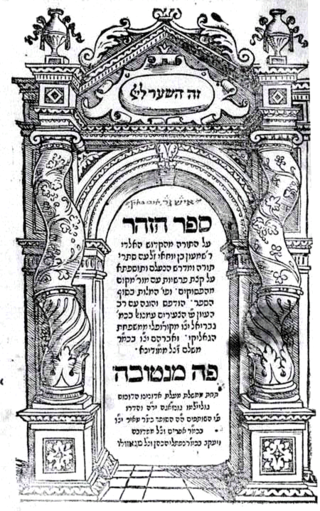
The Zohar is a foundational work in the literature of Jewish mystical thought known as Kabbalah. It is a group of books including commentary on the mystical aspects of the Torah and scriptural interpretations as well as material on mysticism, mythical cosmogony, and mystical psychology. The Zohar contains discussions of the nature of God, the origin and structure of the universe, the nature of souls, redemption, the relationship of Ego to Darkness and "true self" to "The Light of God".

The Masoretic Text is the authoritative Hebrew and Aramaic text of the 24 books of the Hebrew Bible (Tanakh) in Rabbinic Judaism. The Masoretic Text defines the Jewish canon and its precise letter-text, with its vocalization and accentuation known as the mas'sora. Referring to the Masoretic Text, masorah specifically means the diacritic markings of the text of the Hebrew scriptures and the concise marginal notes in manuscripts of the Tanakh which note textual details, usually about the precise spelling of words. It was primarily copied, edited and distributed by a group of Jews known as the Masoretes between the 7th and 10th centuries of the Common Era (CE). The oldest known complete copy, the Leningrad Codex, dates from the early 11th century CE.
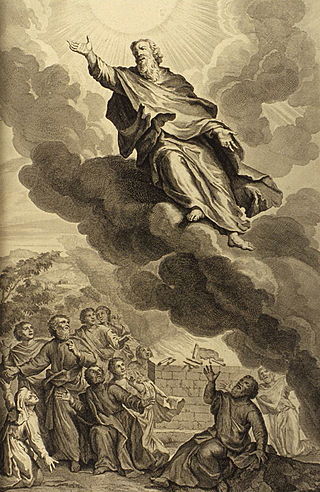
Enoch is a biblical figure and patriarch prior to Noah's flood, and the son of Jared and father of Methuselah. He was of the Antediluvian period in the Hebrew Bible.
Tubal, in Genesis 10, was the name of a son of Japheth, son of Noah. He is known to be the father of the Caucasian Iberians according to primary sources. Later, Saint Jerome refashioned the Caucasian Iberia (Georgia) into the Iberian Peninsula and Isidore of Seville consolidated this mistake.
The Jewish name has historically varied, encompassing throughout the centuries several different traditions. This article looks at the onomastics practices of the Jewish people, that is, the history of the origin and forms of proper names.
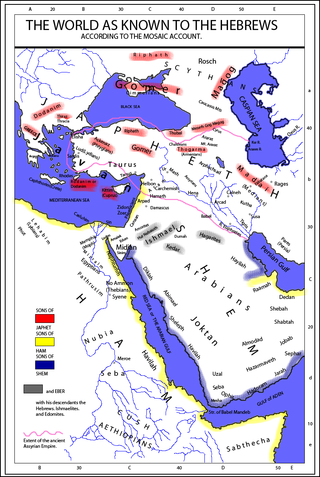
Togarmah is a figure in the "table of nations" in Genesis 10, the list of descendants of Noah that represents the peoples known to the ancient Hebrews. Togarmah is among the descendants of Japheth and is thought to represent some people located in Anatolia. Medieval sources claimed that Togarmah was the legendary ancestor of several peoples of the Caucasus as well as several Turkic peoples.
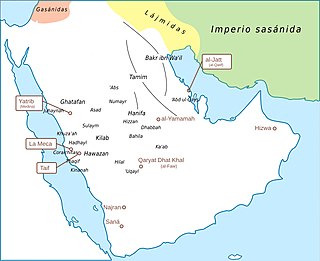
The Ishmaelites were a collection of various Arabian tribes, confederations and small kingdoms described in Islamic tradition as being descended from and named after Ishmael, a prophet according to the Quran, the first son of Abraham and the Egyptian Hagar.

Josippon is a chronicle of Jewish history from Adam to the age of Titus. It is named after its supposed author, Josephus Flavius, though it was actually composed in the 10th century in Southern Italy. The Ethiopic version of Josippon is recognized as canonical by the Ethiopian Orthodox Tewahedo Church and the Eritrean Orthodox Tewahedo Church.

Moses Gaster was a Romanian, later British scholar, the Hakham of the Spanish and Portuguese Jewish congregation, London, and a Hebrew and Romanian linguist. Moses Gaster was an active Zionist in Romania as well as in England, where in 1899 he helped establish the English Zionist Federation.

Ishtori Haparchi (1280-1355), also Estori Haparchi and Ashtori ha-Parhi is the pen name of the 14th-century Jewish physician, geographer, and traveller, Isaac HaKohen Ben Moses.

Michael Friedländer was an Orientalist and principal of Jews' College, London. He is best known for his English translation of Maimonides' Guide to the Perplexed, which was the most popular such translation until the more recent work of Shlomo Pines, and still remains in print.

Yalkut haMachiri is a work of midrash. Its author was Machir ben Abba Mari, but his country and the period in which he lived are not definitively known. Moritz Steinschneider says that Machir lived in Provence; but his date remains a subject of discussion among modern scholars. Strack & Stemberger (1991) say that the work was most probably composed in the late 13th or 14th century.

Mosaic authorship is the Judeo-Christian tradition that the Torah, the first five books of the Hebrew Bible/Old Testament, were dictated by God to Moses. The tradition probably began with the legalistic code of the Book of Deuteronomy and was then gradually extended until Moses, as the central character, came to be regarded not just as the mediator of law but as author of both laws and narrative.
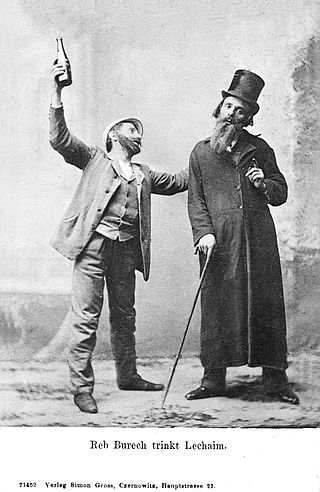
Jewish folklore are legends, music, oral history, proverbs, jokes, popular beliefs, fairy tales, stories, tall tales, and customs that are the traditions of Judaism. Folktales are characterized by the presence of unusual personages, by the sudden transformation of men into beasts and vice versa, or by other unnatural incidents. A number of aggadic stories bear folktale characteristics, especially those relating to Og, King of Bashan, which have the same exaggerations as have the lügenmärchen of modern German folktales.
The Book of Joshua, sometimes called the Samaritan Chronicle, is a Samaritan chronicle so called because the greater part of it is devoted to the history of Joshua. It is extant in two divergent recensions, one in Samaritan Hebrew and the other in Arabic.

The Bible makes reference to various pharaohs of Egypt. These include unnamed pharaohs in events described in the Torah, as well as several later named pharaohs, some of whom were historical or can be identified with historical pharaohs.
The Tolidah or Tulida is the oldest Samaritan historical work. Written mainly in Hebrew, with sections in hybrid Samaritan Hebrew and Aramaic, the book provides a concise summary of Samaritan history and the dynasty of kohanim up to the Middle Ages.
The Asaṭīr, also known as the Samaritan Book of the Secrets of Moses, is a collection of Samaritan Biblical legends, parallel to the Jewish Midrash, and which draws heavily upon oral traditions known among Jews in the 2nd and 3rd centuries CE. Moses Gaster places its compilation about the middle or end of the third century BCE, and rendered a translation of the work in 1927 with the Royal Asiatic Society in London. Others have said that its language style resembles more the Arabic language used by the scholar Ab Ḥisda [Isda] of Tyre in his poems of the eleventh century CE, and place its composition in the second-half of the tenth-century. The book's title, Asatir, was thought by Gaster to mean "secrets," from which name, he applied to the book its newer title, "The Secrets of Moses." Even so, such an interpretation has nothing to do with the contents of the book, nor with its subject. A more precise translation of the Arabic title of the work, al-Asāṭīr, would be "legends" or "tales," as in the Koranic expression asāṭīr al-Awwalīn.

The composition of the Torah was a process that involved multiple authors over an extended period of time. While Jewish tradition holds that all five books were originally written by Moses sometime in the 2nd millennium BCE, leading scholars have rejected Mosaic authorship since the 17th century.













